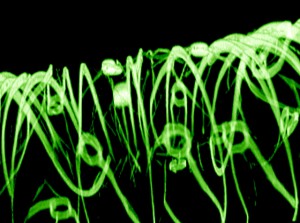There will be a plethora of chemistry news online over the next few days as the American Society’s (ACS) 248th meeting in San Francisco, CA from Aug. 10 -14, 2014 takes place. Unexpectedly, an Aug. 11, 2014 news item on Azonano highlights a meeting presentation focused on cyborgs,
No longer just fantastical fodder for sci-fi buffs, cyborg technology is bringing us tangible progress toward real-life electronic skin, prosthetics and ultraflexible circuits. Now taking this human-machine concept to an unprecedented level, pioneering scientists are working on the seamless marriage between electronics and brain signaling with the potential to transform our understanding of how the brain works — and how to treat its most devastating diseases.
An Aug. 10, 2014 ACS news release on EurekAlert provides more detail about the presentation (Note: Links have been removed),
“By focusing on the nanoelectronic connections between cells, we can do things no one has done before,” says Charles M. Lieber, Ph.D. “We’re really going into a new size regime for not only the device that records or stimulates cellular activity, but also for the whole circuit. We can make it really look and behave like smart, soft biological material, and integrate it with cells and cellular networks at the whole-tissue level. This could get around a lot of serious health problems in neurodegenerative diseases in the future.”
These disorders, such as Parkinson’s, that involve malfunctioning nerve cells can lead to difficulty with the most mundane and essential movements that most of us take for granted: walking, talking, eating and swallowing.
Scientists are working furiously to get to the bottom of neurological disorders. But they involve the body’s most complex organ — the brain — which is largely inaccessible to detailed, real-time scrutiny. This inability to see what’s happening in the body’s command center hinders the development of effective treatments for diseases that stem from it.
By using nanoelectronics, it could become possible for scientists to peer for the first time inside cells, see what’s going wrong in real time and ideally set them on a functional path again.
For the past several years, Lieber has been working to dramatically shrink cyborg science to a level that’s thousands of times smaller and more flexible than other bioelectronic research efforts. His team has made ultrathin nanowires that can monitor and influence what goes on inside cells. Using these wires, they have built ultraflexible, 3-D mesh scaffolding with hundreds of addressable electronic units, and they have grown living tissue on it. They have also developed the tiniest electronic probe ever that can record even the fastest signaling between cells.
Rapid-fire cell signaling controls all of the body’s movements, including breathing and swallowing, which are affected in some neurodegenerative diseases. And it’s at this level where the promise of Lieber’s most recent work enters the picture.
In one of the lab’s latest directions, Lieber’s team is figuring out how to inject their tiny, ultraflexible electronics into the brain and allow them to become fully integrated with the existing biological web of neurons. They’re currently in the early stages of the project and are working with rat models.
“It’s hard to say where this work will take us,” he says. “But in the end, I believe our unique approach will take us on a path to do something really revolutionary.”
Lieber acknowledges funding from the U.S. Department of Defense, the National Institutes of Health and the U.S. Air Force.
I first covered Lieber’s work in an Aug. 27, 2012 posting highlighting some good descriptions from Lieber and his colleagues of their work. There’s also this Aug. 26, 2012 article by Peter Reuell in the Harvard Gazette (featuring a very good technical description for someone not terribly familiar with the field but able to grasp some technical information while managing their own [mine] ignorance). The posting and the article provide details about the foundational work for Lieber’s 2014 presentation at the ACS meeting.
Lieber will be speaking next at the IEEE (Institute for Electrical and Electronics Engineers) 14th International Conference on Nanotechnology sometime between August 18 – 21, 2014 in Toronto, Ontario, Canada.
As for some of Lieber’s latest published work, there’s more information in my Feb. 20, 2014 posting which features a link to a citation for the paper (behind a paywall) in question.
